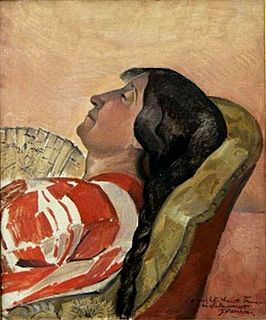
The Froissart of Louis of Gruuthuse is a heavily illustrated deluxe illuminated manuscript in four volumes, containing a French text of Froissart's Chronicles, written and illuminated in the first half of the 1470s in Bruges, Flanders, in modern Belgium. The text of Froissart's Chronicles is preserved in more than 150 manuscript copies. This is one of the most lavishly illuminated examples, commissioned by Louis of Gruuthuse, a Flemish nobleman and bibliophile.

Bibliothèque François Mitterrand is a station of the Paris Métro and RER, named after the former French president, François Mitterrand, and serving the area surrounding the new building of the Bibliothèque nationale de France (BnF), whose site near the station is also named after Mitterrand, and the Paris Diderot University. It is a transfer point between Line 14 of the Paris Metro and the RER C. It is situated on the Paris–Bordeaux railway.

Girart de Roussillon, also called Girard, Gérard II, Gyrart de Vienne, and Girart de Fraite, was a Burgundian chief who became Count of Paris in 837, and embraced the cause of Lothair I against Charles the Bald. He was a son of Leuthard I, Count of Fézensac and of Paris, and his wife Grimildis.

The Guirlande de Julie is a unique French manuscript of sixty-one madrigaux, illustrated with painted flowers, and composed by several poets habitués of the Hôtel de Rambouillet for Julie d'Angennes and given to her on her name day in May 1641. The 1641 manuscript was bought by the Bibliothèque nationale de France in 1989 and is now kept in the Département des Manuscrits of the BnF.
Claude Dupuy (1545–1594), a Parisian jurist, humanist and bibliophile, was a leading figure in the circle of French legal humanists and historians that gathered around Jacques Cujas and Jacques-Auguste de Thou. Dupuy (Puteanus) assembled a great library of manuscripts that was inherited by his sons Pierre, a noted scholar himself, and Jacques, but when Jacques died in 1657, the books and manuscripts entered the Royal Collection and are now in the Bibliothèque Nationale, Paris. Codices from his library are identifiable under the title Codex Puteanus. Among his most celebrated manuscripts are the St. Paul's Epistles in Greek and Latin ; a collection of Tironian notes. His ninth-century Statius, his Tertullian Apologeticum and his fifth century codex of Livy's Third Decade were among the group of his manuscripts that came from the Abbey of Corbie, acquired by foul means or fair. "Claude Dupuy was not interested in illuminated manuscripts; he looked for good and correct texts, elegantly written. He read, and sometimes annotated them." He died too young to publish the results of his research, but his long correspondence with Gian Vincenzo Pinelli has been edited by Anna Maria Raugei.
Jean Pierre Philippe Lampué (1836–1924) was a 19th-century French politician and photographer who worked for the "École of Beaux Arts of Paris".
Henri Auguste Omont was a French librarian, philologist, and historian.

Paris, the capital of France, has many of the country's most important libraries. The Bibliothèque nationale de France operates public libraries in Paris, among them the François-Mitterrand, Richelieu, Louvois, Opéra, and Arsenal.

The codex Parisino-petropolitanus is one of the oldest extant manuscripts of the Quran, dated to the 7th or 8th century.

Jeanne-Henriette Tirman was a French woman painter and printmaker.
The Armorial d'Auvergne is a 15th-century manuscript by Guillaume Revel, composed initially for Charles I, Duke of Bourbon but dedicated to Charles VII of France. It contains pages dedicated to the Duke's holdings in Auvergne, Forez, and Bourbon, with most pages containing a sketch and/or watercolor illuminations of the region named at the top of the page as well as sketches and/or colored miniatures of the associated heraldic arms in the form of a shield or helmets. It is housed at the Bibliothèque nationale de France as ms. 22297.
BnF Français 25516 is an early-13th c. illuminated manuscript held in the Bibliothèque nationale de France.
The Master of Robert Gaguin was an anonymous painter, active in Paris around 1485–1500. He was so named by Nicole Reynaud after a manuscript of Robert Gaguin's translation of Julius Caesar's De Bello Gallico, offered by the translator to Charles VIII, king of France. He belongs to a circle of French artists, whose art follows the style of the Master François.
Jean Vezin is a French librarian and medievalist historian, specializing in Latin palaeography and codicology.
Catherine Massip is a French curator of libraries and musicologist.

De balneis Puteolanis is a medieval didactic poem in Latin, attributed to Peter of Eboli, describing the thermal baths of Pozzuoli in the Campi Flegrei region of Campania. The poem has the alternative title De balneis terrae laboris.
L'âtre périlleux is an anonymous 13th century poem written in Old French in which Gawain is the hero. The name comes from just one of the adventures Gawain takes part in. Forced to spend the night in a chapel in a cemetery, he encounters a woman who has been cursed and is forced to spend the night with a devil each night. He defeats the devil and liberates her. The story draws on influences from other Arthurian romances, such as those of Raoul de Houdenc and Chrétien de Troyes.
Nicole Wild was a French musicologist, chief curator at the Paris Opera Library and Museum, and a specialist in the history and iconography of opera in France in the 19th century.











